Coupling Effects of Sandstorm and Dust from Coal Bases on the Atmospheric Environment of Northwest China
Abstract
1. Introduction
2. Data Sources and Methods
2.1. Study Area
2.2. Satellite Data and Air Pollution Monitoring Data
2.3. Chemical Analysis
2.3.1. Metal Elements
2.3.2. Water-Soluble Inorganic Ions
2.4. Source Identification Methods
2.4.1. PMF
2.4.2. Backward Clustering Trajectory
2.5. Health Risk Assessment
3. Results
3.1. Sandstorm Transport Process Based on Remote Sensing Observations
3.2. Particulate Matter Concentration Observation
3.2.1. Spatial Distribution
3.2.2. Temporal Variation
3.2.3. Chemical Composition of Particulate Matter
3.3. Analysis of Pollutants Sources
3.3.1. PMF
3.3.2. Analysis of Dust Transport Paths Based on MeteoInfo Trajectory Model
3.4. Health Risk Assessment
4. Discussion
4.1. Comparison of Pollutant Characteristics
4.2. Comparison of Pollutants Sources
4.3. Impact of Pollutants on Human Health
5. Conclusions
Supplementary Materials
Author Contributions
Acknowledgments
Conflicts of Interest
References
- Yassin, M.F.; Almutairi, S.K.; Al-Hemoud, A. Dust storms backward Trajectories’ and source identification over Kuwait. Atmos. Res. 2018, 212, 158–171. [Google Scholar] [CrossRef]
- Kang, J.H.; Keller, J.J.; Chen, C.S.; Lin, H.C. Asian dust storm events are associated with an acute increase in pneumonia hospitalization. Ann. Epidemiol. 2012, 22, 257–263. [Google Scholar] [CrossRef] [PubMed]
- Trianti, S.M.; Samoli, E.; Rodopoulou, S.; Katsouyanni, K.; Papiris, S.A.; Karakatsani, A. Desert dust outbreaks and respiratory morbidity in Athens, Greece. Environ. Health 2017, 16, 72. [Google Scholar] [CrossRef]
- Vodonos, A.; Friger, M.; Katra, I.; Avnon, L.; Krasnov, H.; Koutrakis, P.; Schwartz, J.; Lior, O.; Novack, V. The impact of desert dust exposures on hospitalizations due to exacerbation of chronic obstructive pulmonary disease. Air Qual. Atmos. Health 2014, 7, 433–439. [Google Scholar] [CrossRef]
- Akinwumiju, A.S.; Ajisafe, T.; Adelodun, A.A. Airborne particulate matter pollution in Akure Metro city, southwestern Nigeria, West Africa: Attribution and meteorological influence. J. Geovis. Spat. Anal. 2021, 5, 11. [Google Scholar] [CrossRef]
- Fernández, A.J.; Sicard, M.; Costa, M.J.; Guerrero-Rascado, J.L.; Gómez-Amo, J.L.; Molero, F.; Barragán, R.; Basart, S.; Bortoli, D.; Bedoya-Velásquez, A.E.; et al. Extreme, wintertime Saharan dust intrusion in the Iberian Peninsula: Lidar monitoring and evaluation of dust forecast models during the February 2017 event. Atmos. Res. 2019, 228, 223–241. [Google Scholar] [CrossRef]
- Filonchyk, M.; Peterson, M.; Hurynovich, V. Air pollution in the Gobi Desert region: Analysis of dust-storm events. Q. J. R. Meteorol. Soc. 2021, 147, 1097–1111. [Google Scholar] [CrossRef]
- Liu, L.; Guo, J.; Gong, H.; Li, Z.; Chen, W.; Wu, R.; Wang, L.; Xu, H.; Li, J.; Chen, D.; et al. Contrasting influence of Gobi and Taklimakan deserts on the dust aerosols in western North America. Geophys. Res. Lett. 2019, 46, 9064–9071. [Google Scholar] [CrossRef]
- An, L.; Che, H.; Min, X.; Zhang, T.; Wang, H.; Wang, Y.; Zhou, C.; Zhao, H.; Gui, K.; Zheng, Y.; et al. Temporal and spatial variations in sand and dust storm events in East Asia from 2007 to 2016: Relationships with surface conditions and climate change. Sci. Total Environ. 2018, 633, 452–462. [Google Scholar] [CrossRef] [PubMed]
- Barbulescu, A.; Nazzal, Y. Statistical analysis of dust storms in the United Arab Emirates. Atmos. Res. 2020, 231, 104669. [Google Scholar] [CrossRef]
- Chen, Q.C.; Wang, M.M.; Sun, H.Y.; Wang, X.; Wang, Y.Q.; Lim, Y.G.; Zhang, L.X.; Mu, Z. Enhanced health risks from exposure to environmentally persistent free radicals and the oxidative stress of PM2.5 from Asian dust storms in Erenhot, Zhangbei and Jinan, China. Environ. Int. 2018, 121, 260–268. [Google Scholar] [CrossRef] [PubMed]
- Ismail, S.; Jean-François, L.; Mar, S.; Benjamin, G.; Carmen, C.J.; Amaury, D.S.; Faisal, A.S. Dust and dust storms over Kuwait: GROUND-BASED and satellite observations. J. Atmos. Sol.-Terr. Phys. 2018, 179, 105–113. [Google Scholar]
- Soleimani, Z.; Teymouri, P.; Boloorani, A.D.; Mesdaghinia, A.; Middleton, N.; Griffin, D.W. An overview of bioaerosol load and health impacts associated with dust storms: A focus on the Middle East. Atmos. Environ. 2020, 223, 117187. [Google Scholar] [CrossRef]
- Tiwari, S.; Kumar, A.; Pratap, V.; Singh, A.K. Assessment of two intense dust storm characteristics over indo-gangetic basin and their radiative impacts: A case study. Atmos. Res. 2019, 228, 23–40. [Google Scholar] [CrossRef]
- Tang, G.L.; Chao, Q.C. Analysis on Sandstorm Variation in China for Last 49 Years. Meteorol. Mon. (China) 2005, 5, 8–11. [Google Scholar]
- Filonchyk, M. Characteristics of the severe March 2021 Gobi Desert dust storm and its impact on air pollution in China. Chemosphere 2021, 287, 132219. [Google Scholar] [CrossRef] [PubMed]
- Liu, Q.Y.; Liu, Y.J.; Zhao, Q.C.; Zhang, T.T.; Schauer, J.J. Increases in the formation of water soluble organic nitrogen during asian dust storm episodes. Atmos. Res. 2021, 253, 105486. [Google Scholar] [CrossRef]
- Wang, G.H.; Cheng, C.L.; Huang, Y.; Tao, J.; Ren, Y.Q.; Wu, F.; Meng, J.J.; Li, J.J.; Cheng, Y.T.; Cao, J.J.; et al. Evolution of aerosol chemistry in Xi’an, inland China, during the dust storm period of 2013—Part 1: Sources, chemical forms and formation mechanisms of nitrate and sulfate. Atmos. Chem. Phys. 2014, 14, 11571–11585. [Google Scholar] [CrossRef]
- Tao, M.; Gui, L.; Li, R.; Wang, L.; Liang, S.; Li, Q.; Wang, L.; Yu, C.; Chen, L. Tracking prevailing dust aerosol over the air pollution in central China with integrated satellite and ground observations. Atmos. Environ. 2021, 253, 118369. [Google Scholar] [CrossRef]
- Zhou, L.; Dang, X.; Mu, H.; Wang, B.; Wang, S. Cities are going uphill: Slope gradient analysis of urban expansion and its driving factors in China. Sci. Total Environ. 2021, 775, 145836. [Google Scholar] [CrossRef] [PubMed]
- Titos, G.; Ealo, M.; Pandolfi, M.; Perez, N.; Sola, Y.; Sicard, M.; Comerón, A.; Querol, X.; Alastuey, A. Spatiotemporal evolution of a severe winter dust event in the western Mediterranean: Aerosol optical and physical properties. J. Geophys. Res. Atmos. 2017, 122, 4052–4069. [Google Scholar] [CrossRef]
- Wang, Q.; Dong, X.; Fu, J.S.; Xu, J.; Deng, C.; Jiang, Y.; Fu, Q.; Lin, Y.; Huang, K.; Zhuang, G. Environmentally dependent dust chemistry of a super Asian dust storm in March 2010: Observation and simulation. Atmos. Chem. Phys. 2018, 18, 3505–3521. [Google Scholar] [CrossRef]
- Zheng, S.; Singh, R.P. Aerosol and meteorological parameters associated with the intense dust event of 15 April 2015 over Beijing, China. Remote Sens. 2018, 10, 957. [Google Scholar] [CrossRef]
- Francis, D.; Eayrs, C.; Chaboureau, J.P.; Mote, T.; Holland, D.M. Polar jet associated circulation triggered a Saharan cyclone and derived the poleward transport of the African dust generated by the cyclone. J. Geophys. Res. Atmos. 2018, 123, 11-899. [Google Scholar] [CrossRef]
- She, L.; Xue, Y.; Guang, J.; Che, Y.; Fan, C.; Li, Y.; Xie, Y. Towards a comprehensive view of dust events from multiple satellite and ground measurements: Exemplified by the May 2017 East Asian dust storm. Nat. Hazards Earth Syst. Sci. 2018, 18, 3187–3201. [Google Scholar] [CrossRef]
- Tan, S.C.; Li, J.; Che, H.; Chen, B.; Wang, H. Transport of East Asian dust storms to the marginal seas of China and the southern North Pacific in spring 2010. Atmos. Environ. 2017, 148, 316–328. [Google Scholar] [CrossRef]
- Yuan, T.; Chen, S.; Huang, J.; Zhang, X.; Luo, Y.; Ma, X.; Zhang, G. Sensitivity of simulating a dust storm over Central Asia to different dust schemes using the WRF-Chem model. Atmos. Environ. 2019, 207, 16–29. [Google Scholar] [CrossRef]
- Li, G.; Lu, D.; Yang, X.; Zhang, H.; Guo, Y.; Qu, G.; Wang, P.; Chen, L.; Ruan, T.; Hou, X.; et al. Resurgence of sandstorms complicates China’s air pollution situation. Environ. Sci. Technol. 2021, 55, 11467–11469. [Google Scholar] [CrossRef]
- Liu, Y.; Wang, R.S.; Zhang, Y.; Zhao, T.N.; Wang, J.H.; Wu, H.X.; Hu, P. Temporal and spatial distributions of particulate matters around mining areas under two coal mining methods in arid desert region of northwest China. Environ. Technol. Innov. 2020, 19, 101029. [Google Scholar] [CrossRef]
- Cheng, M.T.; Tang, G.Q.; Lv, B.; Li, X.R.; Wu, X.R.; Wang, Y.M.; Wang, Y.S. Source apportionment of PM2.5 and visibility in Jinan, China. J. Environ. Sci. (China) 2021, 102, 207–215. [Google Scholar] [CrossRef]
- Wang, Y.Q. MeteoInfo: GIS software for meteorological data visualization and analysis. Meteorol. Appl. 2012, 21, 360–368. [Google Scholar] [CrossRef]
- Lee, S.; Ashbaugh, L. The impact of trajectory starting heights on the MURA trajectory source apportionment (TSA) method. Atmos. Environ. 2007, 41, 7022–7036. [Google Scholar] [CrossRef]
- Sapkota, A.; Symons, J.M.; Kleissl, J.; Wang, L.; Parlange, M.B.; Ondov, J.; Breysse, P.N.; Diette, G.B.; Eggleston, P.A.; Buckley, T.J. Impact of the 2002 Canadian forest fires on particulate matter air quality in Baltimore City. Environ. Sci. Technol. 2005, 39, 24–32. [Google Scholar] [CrossRef] [PubMed]
- GB 3095-2012; CNRAES (Chinese Research Academy Environmental Sciences). Ambient Air Quality Standards. Chinese Research Academy Environmental Sciences: Beijing, China, 2012.
- Yang, Y.J.; Zhou, R.; Yan, Y.; Yu, Y.; Liu, J.; Di, Y.; Du, Z.; Wu, D. Seasonal variations and size distributions of water-soluble ions of atmospheric particulate matter at Shigatse, Tibetan Plateau. Chemosphere 2016, 145, 560–567. [Google Scholar] [CrossRef] [PubMed]
- Wang, W.D.; Chen, H.S.; Wu, Q.Z.; Wei, L.F.; Wang, Z.F.; Li, C.; Chen, D.H.; Jiang, Z.M.; Wu, W.W. Numerical study of PM2.5 regional transport over Pearl River Delta during a winter heavy haze event. Acta Sci. Circumstantiae (China) 2016, 36, 2741–2751. [Google Scholar]
- Yu, G.M.; Xu, J.Z.; Kang, S.C.; Ren, J.W.; Cui, X.Q. Trajectory analysis of atmospheric transport of particles in Laohugou area, Western Qilian Mountains. Arid Zone Res. (China) 2020, 37, 671–679. [Google Scholar]
- Xie, J.W.; Jin, L.; Cui, J.L.; Luo, X.S.; Li, J.; Zhang, G.; Li, X.D. Health risk oriented source apportionment of PM2.5-associated trace metals. Environ. Pollut. 2020, 262, 114655. [Google Scholar] [CrossRef]
- Lin, Y.C.; Li, Y.C.; Amesho, K.T.T.; Chou, F.C.; Cheng, P.C. Filterable PM2.5, metallic elements, and organic carbon emissions from the exhausts of diesel vehicles. Aerosol Air Qual. Res. 2020, 20, 1319–1328. [Google Scholar] [CrossRef]
- Elif, Y.; Akif, A.; Ahmet, A. Land application of municipal sewage sludge: Human health risk assessment of heavy metals. J. Clean. Prod. 2021, 319, 128568. [Google Scholar]
- Guo, G.; Zhang, D.; Wang, Y. Characteristics of heavy metals in size-fractionated atmospheric particulate matters and associated health risk assessment based on the respiratory deposition. Environ. Geochem. Health 2021, 43, 285–299. [Google Scholar] [CrossRef]
- Penttinen, P.K.; Timonen, K.L.; Tiittanen, P.; Mirme, A.; Ruuskanen, J.; Pekkanen, J. Ultrafine particles in urban air and respiratory health among adult asthmatics. Eur. Respir. J. 2001, 17, 428–435. [Google Scholar] [CrossRef]
- He, R.-D.; Zhang, Y.-S.; Chen, Y.-Y.; Jin, M.-J.; Han, S.-J.; Zhao, J.-S.; Zhang, R.-Q.; Yan, Q.-S. Heavy Metal Pollution Characteristics and Ecological and Health Risk Assessment of Atmospheric PM2. 5 in a Living Area of Zhengzhou City. Huan Jing ke Xue= Huanjing Kexue. 2019, 40, 4774–4782. [Google Scholar]
- Beijing Quality and Technology Supervision Bureau. Environmental Site Assessment Guideline; DB11/T 656-2009; Beijing Quality and Technology Supervision Bureau: Beijing, China, 2009. [Google Scholar]
- Kuo, S.-C.; Hsieh, L.-Y.; Tsai, C.-H.; Tsai, Y.I. Characterization of PM2.5 fugitive metal in the workplaces and the surrounding environment of a secondary aluminum smelter. Atmos. Environ. 2007, 41, 6884–6900. [Google Scholar] [CrossRef]
- Li, S.L. Characteristics and Source Analysis of Dust Pollution in Jinan City; Shandong Jianzhu University: Jinan, China, 2019. [Google Scholar]
- Amato, F.; Viana, M.; Richard, A.; Furger, M.; Prévôt, A.S.H.; Nava, S.; Lucarelli, F.; Bukowiecki, N.; Alastuey, A.; Reche, C.; et al. Size and time-resolved roadside enrichment of atmospheric particulate pollutants. Atmos. Chem. Phys. 2011, 11, 2917–2931. [Google Scholar] [CrossRef]
- Grigoratos, T.; Martini, G. Brake wear particle emissions: A review. Environ. Sci. Pollut. Res. 2014, 22, 2491–2504. [Google Scholar] [CrossRef] [PubMed]
- Lin, Y.C.; Zhang, Y.L.; Song, W.; Yang, X.; Fan, M.Y. Specific sources of health risks caused by size-resolved pm-bound metals in a typical coal-burning city of northern China plain during the winter haze event. Sci. Total Environ. 2020, 734, 138651. [Google Scholar] [CrossRef] [PubMed]
- Altıntas, Y.; Kaygısız, Y.; Öztürk, E.; Aksöz, S.; Keşlioğlu, K.; Maraşlı, N. The measurements of electrical and thermal conductivity variations with temperature and phonon component of the thermal conductivity in Sn-Cd-Sb, Sn-In-Cu, Sn-Ag-Bi and Sn-Bi-Zn alloys. Int. J. Therm. Sci. 2016, 100, 1–9. [Google Scholar] [CrossRef]
- Bozkurt, Z.; Gaga, E.O.; Taşpınar, F.; Arı, A.; Pekey, B.; Pekey, H.; Döğeroğlu, T.; Üzmez, Ö.Ö. Atmospheric ambient trace element concentrations of PM10 at urban and sub-urban sites: Source apportionment and health risk estimation. Environ. Monit. Assess. 2018, 190, 1–17. [Google Scholar] [CrossRef]
- Ledoux, F.; Kfoury, A.; Delmaire, G.; Roussel, G.; El Zein, A.; Courcot, D. Contributions of local and regional anthropogenic sources of metals in PM2.5 at an urban site in northern France. Chemosphere 2017, 181, 713–724. [Google Scholar] [CrossRef]
- Zhang, X.; Chen, W.; Ma, C.; Zhan, S. Modeling particulate matter emissions during mineral loading process under weak wind simulation. Sci. Total Environ. 2013, 449, 168–173. [Google Scholar] [CrossRef]
- Zhang, R.J.; Jing, J.; Tao, J.; Hsu, S.C.; Wang, G.; Cao, J. Chemical characterization and source apportionment of PM2.5 in Beijing: Seasonal perspective. Atmos. Chem. Phys. 2013, 13, 7053–7074. [Google Scholar] [CrossRef]
- Lin, Y.-C.; Tsai, C.-J.; Wu, Y.-C.; Zhang, R.; Chi, K.-H.; Huang, Y.-T.; Lin, S.-H.; Hsu, S.-C. Characteristics of trace metals in traffic-derived particles in Hsuehshan Tunnel, Taiwan: Size distribution, potential source, and fingerprinting metal ratio. Atmos. Chem. Phys. 2015, 15, 4117–4130. [Google Scholar] [CrossRef]
- Minguillón, M.; Monfort, E.; Escrig, A.; Celades, I.; Guerra, L.; Busani, G.; Sterni, A.; Querol, X. Air quality comparison between two European ceramic tile clusters. Atmos. Environ. 2013, 74, 311–319. [Google Scholar] [CrossRef][Green Version]
- Xue, G.-Q.; Zhu, B.; Wang, H.-L. Size distributions and source apportionment of soluble ions in aerosol in Nanjing. Huan jing ke xue=Huanjing kexue 2014, 35, 1633–1643. [Google Scholar] [PubMed]
- Kong, S.; Han, B.; Bai, Z.; Chen, L.; Shi, J.; Xu, Z. Receptor modeling of PM2.5, PM10 and TSP in different seasons and long-range transport analysis at a coastal site of Tianjin, China. Sci. Total Environ. 2010, 408, 4681–4694. [Google Scholar] [CrossRef]
- Wang, Y.; Zhuang, G.; Sun, Y.; An, Z. The variation of characteristics and formation mechanisms of aerosols in dust, haze, and clear days in Beijing. Atmos. Environ. 2006, 40, 6579–6591. [Google Scholar] [CrossRef]
- Guo, W.; Zhang, Z.-Y.; Zhang, N.J.; Luo, L.; Xiao, H.Y.; Xiao, H.W. Chemical characterization and source analysis of water-soluble inorganic ions in PM2.5 from a plateau city of Kunming at different seasons. Atmos. Res. 2020, 234, 104687. [Google Scholar] [CrossRef]
- Zhao, J.; Zhang, F.; Xu, Y.; Chen, J. Characterization of water-soluble inorganic ions in size-segregated aerosols in coastal city, Xiamen. Atmos. Res. 2011, 99, 546–562. [Google Scholar] [CrossRef]
- Eliani, E.; Nicola, M.; Jonathan, G.; Tara, K.B.; Zoe, K.S.; Iain, J.B. Measurement of diesel combustion-related air pollution downwind of an experimental unconventional natural gas operations site. Atmos. Environ. 2018, 189, 30–40. [Google Scholar]
- McCulloch, A.; Aucott, M.L.; Benkovitz, C.M.; E Graedel, T.; Kleiman, G.; Midgley, P.M.; Li, Y.-F. Global emissions of hydrogen chloride and chloromethane from coal combustion, incineration and industrial activities: Reactive Chlorine Emissions Inventory. J. Geophys. Res. Earth Surf. 1999, 104, 8391–8403. [Google Scholar] [CrossRef]
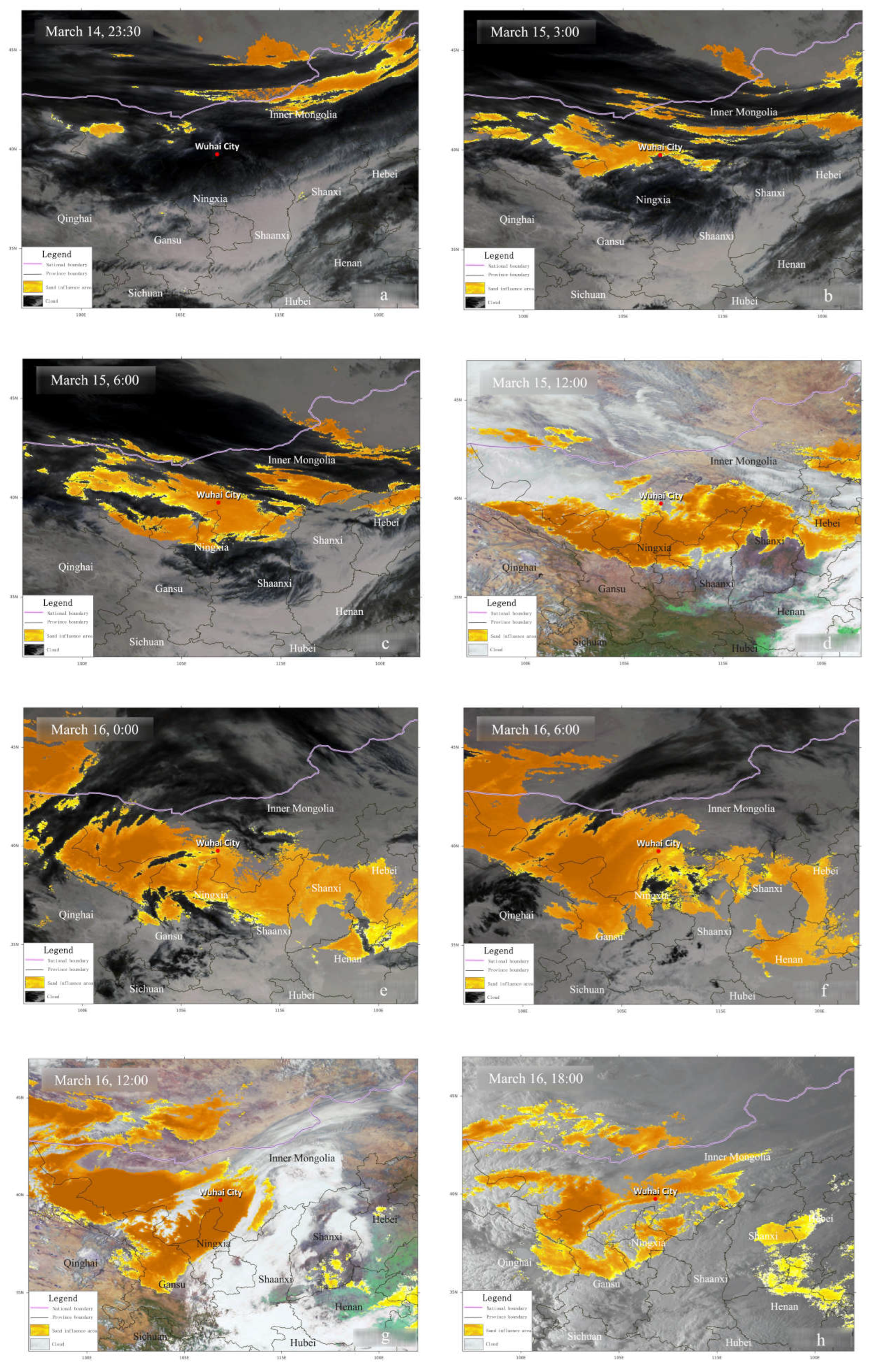
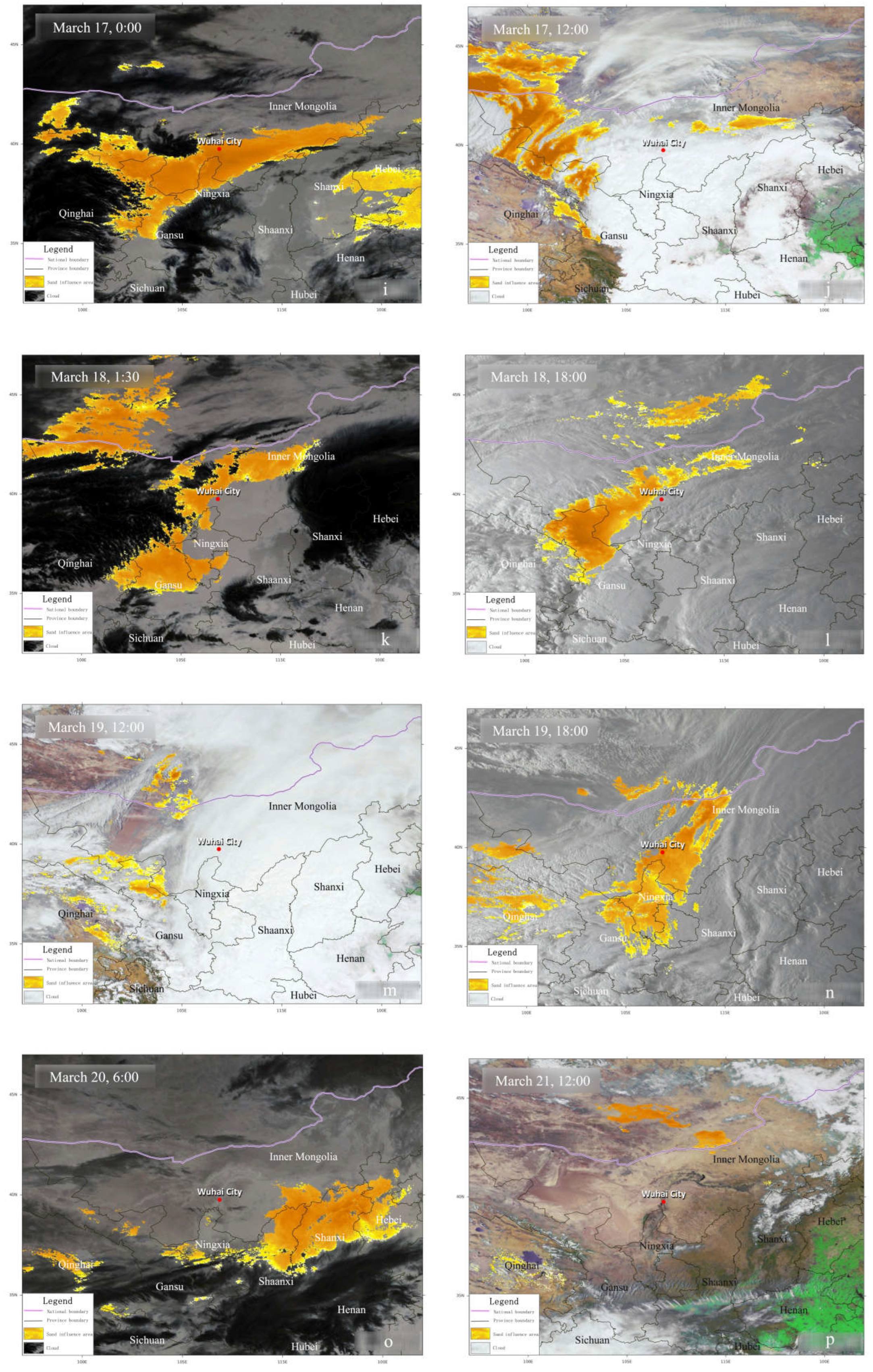
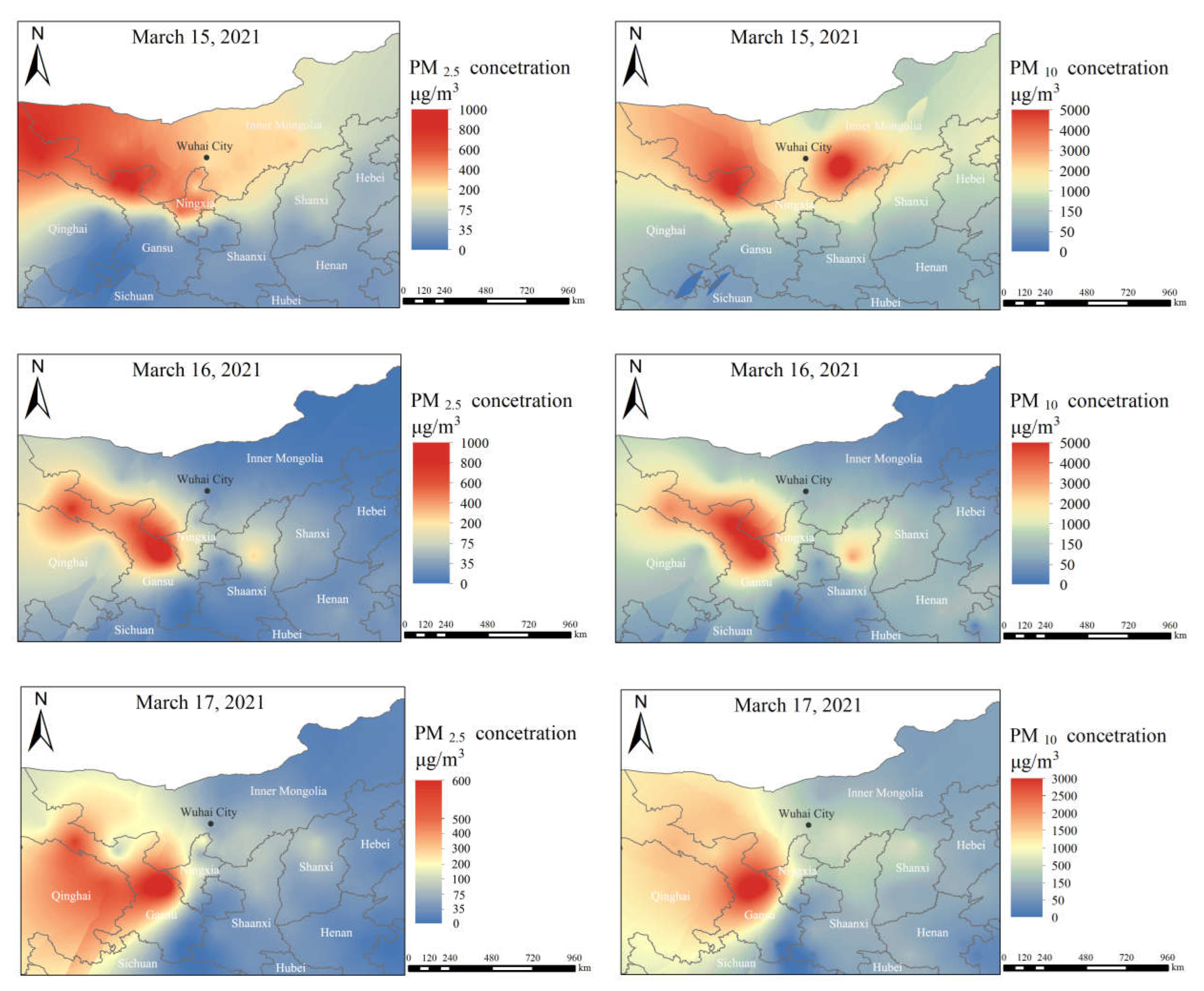
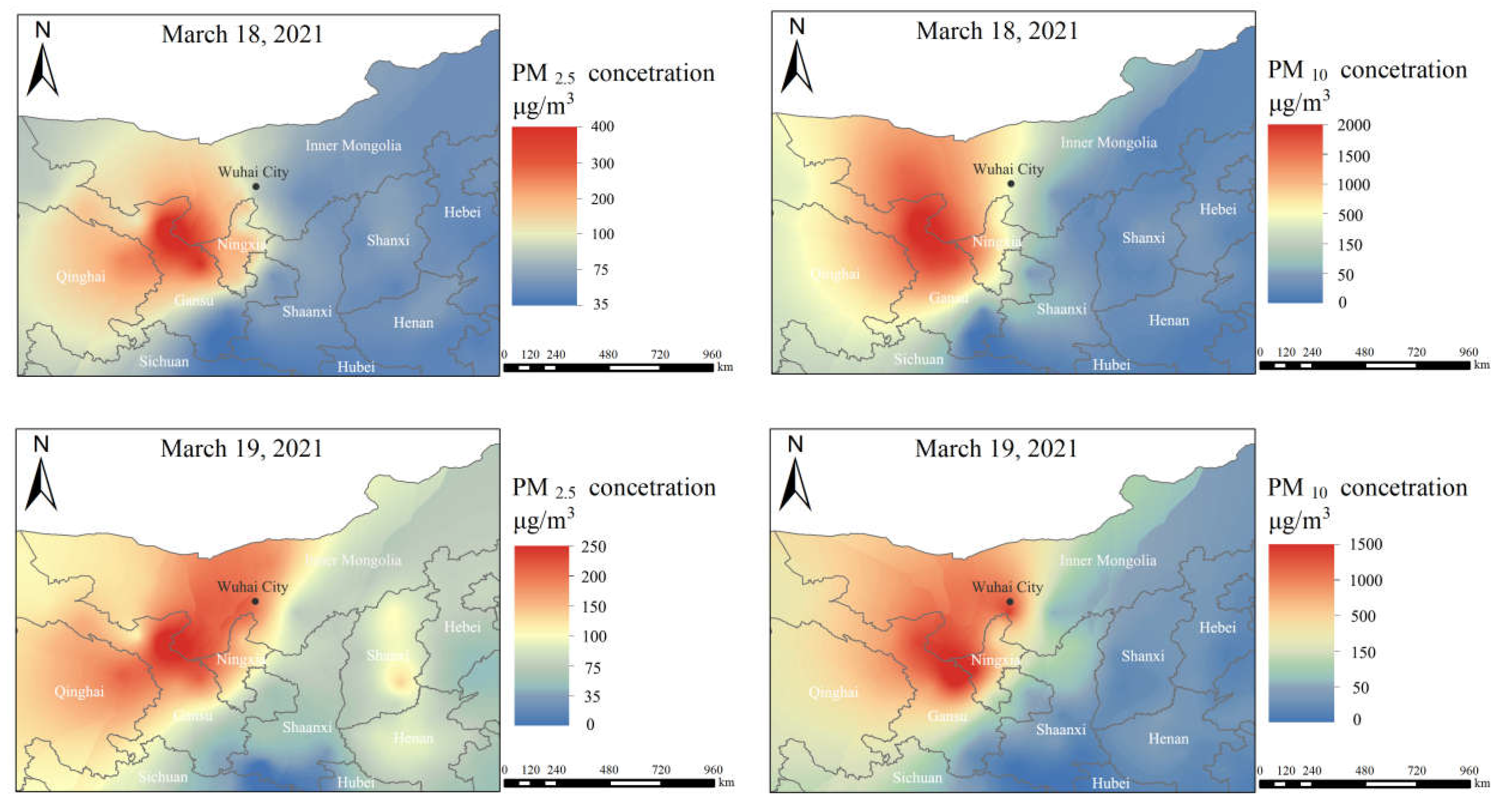



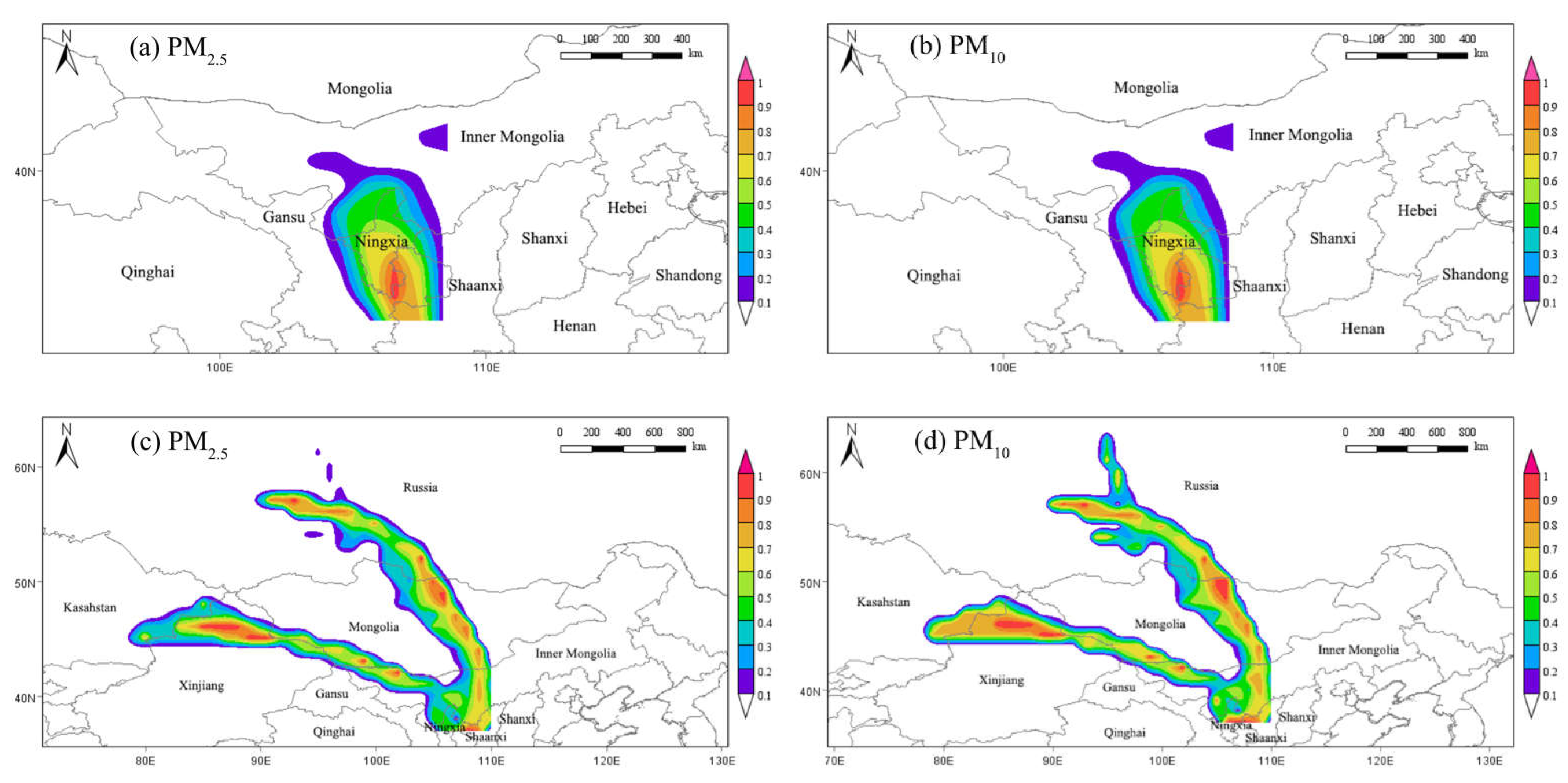
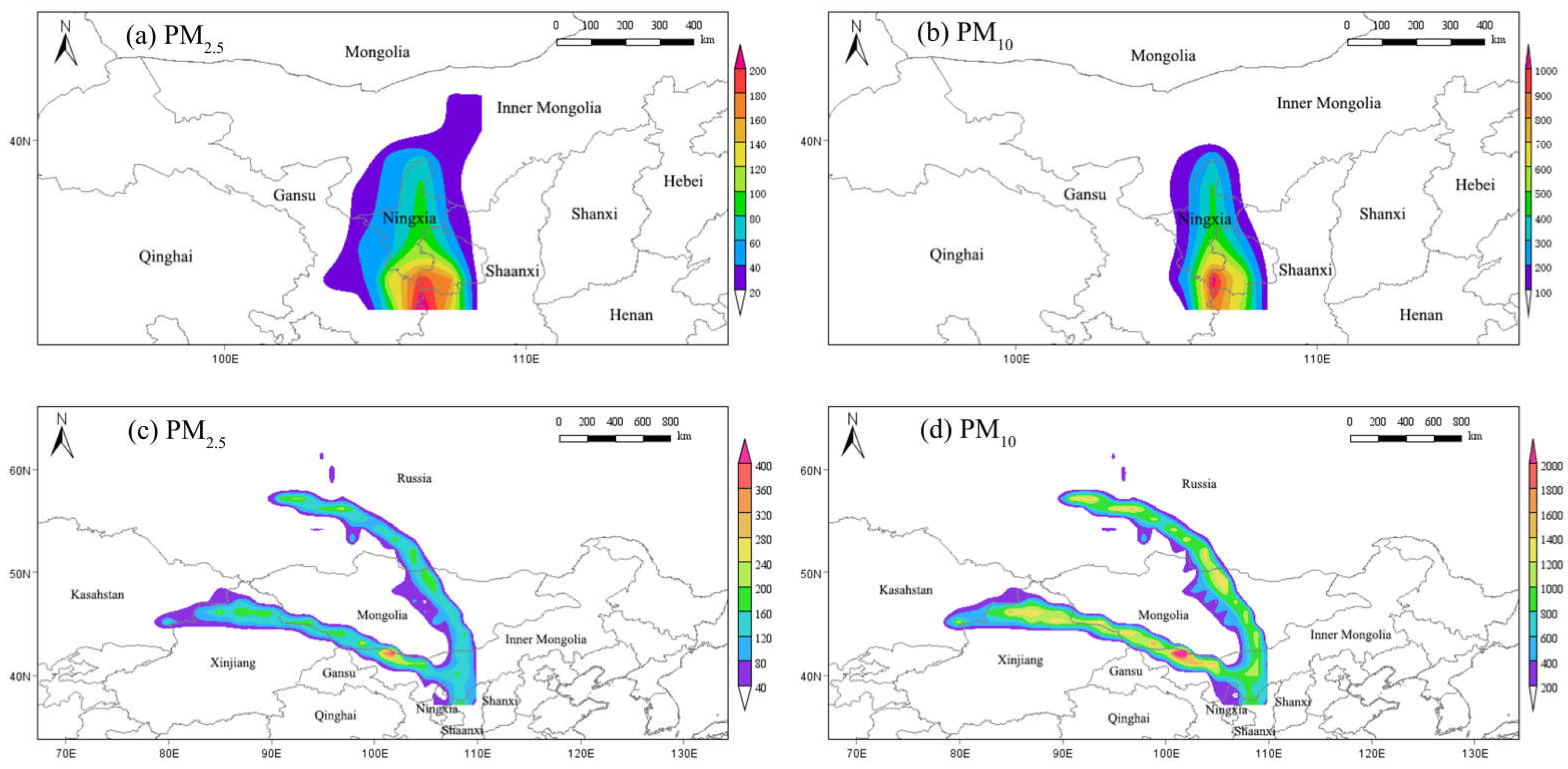
| Element | CR | HQ | ||||||
|---|---|---|---|---|---|---|---|---|
| Adult Male | Adult Women | Children | Adult Male | Adult Women | Children | |||
| PM1 | Non-sandstorm | Cr | 6.57 × 10−3 | 6.25 × 10−3 | 1.53 × 10−2 | 2.31 | 2.06 | 12.98 |
| Cu | ne | ne | ne | 3.19 × 10−5 | 2.84 × 10−5 | 1.79 × 10−4 | ||
| Mn | ne | ne | ne | 1.72 | 1.53 | 9.66 | ||
| Pb | ne | ne | ne | 1.82 × 10−2 | 1.62 × 10−2 | 1.02 × 10−1 | ||
| Zn | ne | ne | ne | 7.69 × 10−3 | 6.84 × 10−3 | 4.3 × 10−2 | ||
| Sandstorm | Cr | 8.17 × 10−3 | 7.77 × 10−3 | 1.90 × 10−2 | 2.80 | 2.56 | 16.14 | |
| Cu | ne | ne | ne | 2.07 × 10−5 | 1.84 × 10−5 | 1.16 × 10−4 | ||
| Mn | ne | ne | ne | 3.25 | 2.89 | 18.22 | ||
| Pb | ne | ne | ne | 3.64 × 10−5 | 3.25 × 10−5 | 2.04 × 10−4 | ||
| Zn | ne | ne | ne | 7.67 × 10−3 | 6.83 × 10−3 | 4.3 × 10−2 | ||
| PM2.5 | Non-sandstorm | Cr | 8.77 × 10−3 | 8.35×10−3 | 2.04×10−2 | 3.09 | 2.75 | 17.33 |
| Cu | ne | ne | ne | 5.94 × 10−5 | 5.29 × 10−5 | 3.33 × 10−4 | ||
| Mn | ne | ne | ne | 0.58 | 1.41 | 8.87 | ||
| Pb | ne | ne | ne | 1.56 × 10−2 | 1.39 × 10−2 | 8.78 × 10−2 | ||
| Zn | ne | ne | ne | 7.87 × 10−3 | 7.01 × 10−3 | 4.41 × 10−2 | ||
| Sandstorm | Cr | 5.91 × 10−3 | 5.63×10−3 | 1.37×10−2 | 2.08 | 1.86 | 11.69 | |
| Cu | ne | ne | ne | 4.84 × 10−5 | 4.31 × 10−5 | 2.71 × 10−4 | ||
| Mn | ne | ne | ne | 5.89 | 5.24 | 33.02 | ||
| Pb | ne | ne | ne | 7.44 × 10−3 | 6.62 × 10−4 | 4.17 × 10−4 | ||
| Zn | ne | ne | ne | 6.2 × 10−3 | 5.52 × 10−3 | 3.48 × 10−2 | ||
| PM10 | Non-sandstorm | Cr | 6.08 × 10−3 | 5.79 × 10−3 | 1.41 × 10−2 | 2.14 | 1.91 | 12.02 |
| Cu | ne | ne | ne | 6.13 × 10−5 | 5.45 × 10−5 | 3.44 × 10−4 | ||
| Mn | ne | ne | ne | 1.29 | 1.15 | 7.25 | ||
| Pb | ne | ne | ne | 8.95 × 10−3 | 7.97 × 10−3 | 5.02 × 10−2 | ||
| Zn | ne | ne | ne | 7.75 × 10−3 | 6.90 × 10−3 | 4.34 × 10−2 | ||
| Sandstorm | Cr | 9.12×10−3 | 8.68×10−3 | 2.12×10−2 | 3.21 | 2.86 | 18.03 | |
| Cu | ne | ne | ne | 9.92 × 10−5 | 8.83 × 10−5 | 5.57 × 10−4 | ||
| Mn | ne | ne | ne | 12.80 | 11.37 | 71.62 | ||
| Pb | ne | ne | ne | 3.24 × 10−3 | 2.89 × 10−3 | 1.82 × 10−2 | ||
| Zn | ne | ne | ne | 6.90×10−3 | 6.14×10−3 | 3.87 × 10−2 | ||
| TSP | Non-sandstorm | Cr | 4.61×10−3 | 4.39×10−3 | 1.07×10−2 | 1.62 | 1.45 | 9.11 |
| Cu | ne | ne | ne | 2.54 × 10−5 | 2.27×10−5 | 1.43×10−4 | ||
| Mn | ne | ne | ne | 1.23 | 1.10 | 6.90 | ||
| Pb | ne | ne | ne | 6.68 × 10−3 | 5.95 × 10−3 | 3.75 × 10−2 | ||
| Zn | ne | ne | ne | 7.82 × 10−3 | 6.96 × 10−3 | 4.38 × 10−2 | ||
| Sandstorm | Cr | 1.05 × 10−2 | 1.00 × 10−2 | 2.45 × 10−2 | 3.71 | 3.31 | 20.83 | |
| Cu | ne | ne | ne | 9.14 × 10−5 | 8.13 × 10−5 | 5.13 × 10−4 | ||
| Mn | ne | ne | ne | 16.08 | 14.32 | 90.20 | ||
| Pb | ne | ne | ne | 6.39 × 10−3 | 5.69 × 10−3 | 3.59 × 10−2 | ||
| Zn | ne | ne | ne | 9.17 × 10−3 | 8.17 × 10−3 | 5.14 × 10−2 | ||
Publisher’s Note: MDPI stays neutral with regard to jurisdictional claims in published maps and institutional affiliations. |
© 2022 by the authors. Licensee MDPI, Basel, Switzerland. This article is an open access article distributed under the terms and conditions of the Creative Commons Attribution (CC BY) license (https://creativecommons.org/licenses/by/4.0/).
Share and Cite
Liu, Y.; Zhao, T.; Wang, R.; Ai, X.; Wang, M.; Sun, T.; Jiang, Q. Coupling Effects of Sandstorm and Dust from Coal Bases on the Atmospheric Environment of Northwest China. Atmosphere 2022, 13, 1629. https://doi.org/10.3390/atmos13101629
Liu Y, Zhao T, Wang R, Ai X, Wang M, Sun T, Jiang Q. Coupling Effects of Sandstorm and Dust from Coal Bases on the Atmospheric Environment of Northwest China. Atmosphere. 2022; 13(10):1629. https://doi.org/10.3390/atmos13101629
Chicago/Turabian StyleLiu, Yun, Tingning Zhao, Ruoshui Wang, Xianfeng Ai, Mengwei Wang, Tao Sun, and Qunou Jiang. 2022. "Coupling Effects of Sandstorm and Dust from Coal Bases on the Atmospheric Environment of Northwest China" Atmosphere 13, no. 10: 1629. https://doi.org/10.3390/atmos13101629
APA StyleLiu, Y., Zhao, T., Wang, R., Ai, X., Wang, M., Sun, T., & Jiang, Q. (2022). Coupling Effects of Sandstorm and Dust from Coal Bases on the Atmospheric Environment of Northwest China. Atmosphere, 13(10), 1629. https://doi.org/10.3390/atmos13101629





